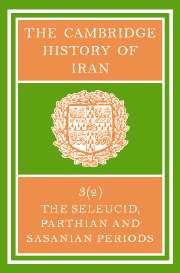Book contents
- Frontmatter
- PART 5 INSTITUTIONS
- 18 IRANIAN SOCIETY AND LAW
- 19 POLITICAL, SOCIAL AND ADMINISTRATIVE INSTITUTIONS, TAXES AND TRADE
- 20 GEOGRAPHICAL AND ADMINISTRATIVE DIVISIONS: SETTLEMENTS AND ECONOMY
- 21(a) TIME-RECKONING
- (b) IRANIAN FESTIVALS
- PART 6 RELIGIOUS HISTORY
- PART 7 ART HISTORY
- PART 8 LANGUAGES AND LITERATURE
- PART 9 BIBLIOGRAPHY
- Bibliography
- Index
- Index of Greek words
- References
20 - GEOGRAPHICAL AND ADMINISTRATIVE DIVISIONS: SETTLEMENTS AND ECONOMY
from PART 5 - INSTITUTIONS
Published online by Cambridge University Press: 28 March 2008
- Frontmatter
- PART 5 INSTITUTIONS
- 18 IRANIAN SOCIETY AND LAW
- 19 POLITICAL, SOCIAL AND ADMINISTRATIVE INSTITUTIONS, TAXES AND TRADE
- 20 GEOGRAPHICAL AND ADMINISTRATIVE DIVISIONS: SETTLEMENTS AND ECONOMY
- 21(a) TIME-RECKONING
- (b) IRANIAN FESTIVALS
- PART 6 RELIGIOUS HISTORY
- PART 7 ART HISTORY
- PART 8 LANGUAGES AND LITERATURE
- PART 9 BIBLIOGRAPHY
- Bibliography
- Index
- Index of Greek words
- References
Summary
A real, if fragile, political unity had again been established over the majority of the Iranian-speaking peoples by the 1st century b.c. Indicative of this process was the generalizing of the term “Aryān” (Eratosthenes' Ariana). Formerly it had designated the kingdom of the Aparni and Parthians in eastern Iran; it now applied to the entire range of Iranian and non-Iranian regions tributary to the Arsacid dynasty. In the centuries that followed, the unity of the state was often illusory; while the topography of the empire and its ethnic, economic, linguistic, and cultural composition remained divisive factors. But the Sasanian concept of Ērān-shahr re-affirmed the ideal of unification contained in “Aryān”; and, by the end of Shāpūr I's reign, Ērān-shahr had attained its greatest stable extent.
An Iranian, at the time of Shāpūr I, could have located himself geographically in two ways. He was, most generally, a resident of Khwānirah. This was the favoured part of the material world, the central one of the seven earth-regions (kishvar). More specifically, his village or town lay within an administrative district (ōstān) of one of the empire's provinces (shahr). His province, already possessing an ancient history, was marked by its distinctive cultural complex. Geographical factors – rivers, mountains, deserts, seas – and the practicable lines of communication helped define it. So, of course, did climate and soil. The Dēnkard, Book iv, records the aphorism: “Produce is found as from a certain province thus according to its type of land”.
- Type
- Chapter
- Information
- The Cambridge History of IranSeleucid Parthian, pp. 747 - 777Publisher: Cambridge University PressPrint publication year: 1983
References
- 4
- Cited by



